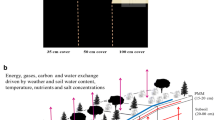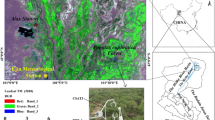Abstract
Balancing human demands for water with environmental requirements to maintain functioning ecosystems requires the quantification of ecological water requirements. In arid regions, high spatial variability of vegetation cover and different water consumption of plant species make it different to estimate reasonable ecological water requirements. We developed a simple and practical approach that estimates the vegetation water requirements (VWRs) of desert riparian ecosystems. This model is species-specific and spatially-explicit; it considers the water consumption characteristics required by different species and highlights the impacts that high vegetation cover spatial variability has in arid regions on evapotranspiration. The model was parameterized based on the observation of the water consumption of two typical desert riparian species, Populus euphratica and Tamarix spp., in the lower basin of the Tarim River in northwestern China. Comparisons between the modeling results and measured data for two mature Populus and Tamarix stands indicate that the model is reasonable predictive. A case study in the lower basin of the Tarim River demonstrated the model’s practicality and transferability. This model could run based on near real-time or forest weather data and spatial vegetation patterns, and provides a continuous estimation of the temporal and spatial variations of the VWR. Particularly, this model forecasts VWRs under different vegetation spatial distribution and coverage scenarios, and evaluates the impacts and consequences of different management actions. This model can serve as a useful tool for management agencies interested in improving their decisions to allocate river water between human activities and natural ecosystems in arid regions.









Similar content being viewed by others
References
Abdurahman M, Kurban A, Ablat A (2008) Study on phenological characters of populus euphratica Oliv. in the lower reaches of the Tarim River Arid Zone Research (in Chinese) 25:525–530
Acreman M et al. (2014) Environmental flows for natural, hybrid, and novel riverine ecosystems in a changing world. Front Ecol Environ 12:466–473. doi:10.1890/130134
Allen RG, Pereira LS, Reas D, Smith M (1998) Guidelines for computing crop water requirements. FAO Irrigation and Drainage Paper No. 56. United Nations, FAO, Roma, Italy
Bai Y (1998) Studies on phenological patterns of the main shrubs in Yanchi sandy land. J Arid Land Resources Environ (in chinese) 12:82–86
Bertrand G, Goldscheider N, Gobat JM, Hunkeler D (2012) Review: From multi-scale conceptualization to a classification system for inland groundwater-dependent ecosystems. Hydrogeol J 20:5–25. doi:10.1007/s10040-011-0791-5
Chen YN (2003) Impact of human activities on water resources and ecological problems in Tarim River basin, China J Exp Bot 54:61–61
Chen YN et al. (2004) Analysis on the ecological benefits of the stream water conveyance to the dried-up river of the lower reaches of Tarim River. China Sci China Ser D 47:1053–1064. doi:10.1360/03yd0101
Daly E, Porporato A, Rodriguez-Iturbe I (2004) Coupled dynamics of photosynthesis, transpiration, and soil water balance. Parst I: Upscaling from Hourly to Daily Level J Hydrometeorol 5:546–558. doi:10.1175/1525-7541(2004)005<0546:CDOPTA>2.0.CO;2
Feng Q, Cheng GD (1998) Current situation, problems and rational utilization of water resources in arid north-western China. J Arid Environ 40:373–382
Feng Q, Liu W, Si JH, Su YH, Zhang YW, Cang ZQ, Xi HY (2005) Environmental effects of water resource development and use in the Tarim River basin of northwestern China. Environ Geol 48:202–210. doi:10.1007/s00254-005-1288-0
Fernandes R, Korolevych V, Wang S (2007) Trends in Land Evapotranspiration over Canada for the Period 1960–2000 Based on In Situ Climate Observations and a Land Surface Model. J Hydrometeorol 8:1016–1030. doi:10.1175/JHM619.1
Foley JA, Prentice IC, Ramankutty N, Levis S, Pollard D, Sitch S, Haxeltine A (1996) An integrated biosphere model of land surface processes, terrestrial carbon balance, and vegetation dynamics. Global Biogeochem Cy 10:603–628. doi:10.1029/96gb02692
Gleick PH (1998) Water in crisis: paths to sustainable water use. Ecol Appl 8:571–579. doi:10.2307/2641249
Hu B, Cui BS, Dong SK, Zhai HJ, Liu ZY (2009) Ecological Water Requirement (EWR) Analysis of High Mountain and Steep Gorge (HMSG) River-Application to Upper Lancang-Mekong River. Water Resour Manag 23:341–366. doi:10.1007/s11269-008-9278-0
Irmak S, Kabenge I, Rudnick D, Knezevic S, Woodward D, Moravek M (2013) Evapotranspiration crop coefficients for mixed riparian plant community and transpiration crop coefficients for common reed, Cottonwood and Peach-leaf Willow in the Platte River Basin, Nebraska-USA. J Hydrol 481:177–190. doi:10.1016/j.jhydrol.2012.12.032
Izadifar Z, Elshorbagy A (2010) Prediction of hourly actual evapotranspiration using neural networks, genetic programming, and statistical models. Hydrol Process 24:3413–3425
Li WH, Zhou HH, Fu AH, Chen YP (2013) Ecological response and hydrological mechanism of desert riparian forest in inland river, northwest of China. Ecohydrology 6:949–955. doi:10.1002/Eco.1385
Ling HB, Guo B, Xu HL, Fu JY (2014) Configuration of water resources for a typical river basin in an arid region of China based on the ecological water requirements (EWRs) of desert riparian vegetation. Glob Planet Chang 122:292–304. doi:10.1016/j.gloplacha.2014.09.008
Liu B, Zhao WZ, Chang XX, Li SB, Zhang ZH, Du MW (2010) Water requirements and stability of oasis ecosystem in arid region. China Environ Earth Sci 59:1235–1244. doi:10.1007/s12665-009-0112-7
Meijer KS, van der Krogt WNM, van Beek E (2012) A New Approach to Incorporating Environmental Flow Requirements in Water Allocation Modeling. Water Resour Manag 26:1271–1286. doi:10.1007/s11269-011-9958-z
Merritt DM, Bateman HL (2012) Linking stream flow and groundwater to avian habitat in a desert riparian system. Ecol Appl 22:1973–1988. doi:10.1890/12-0303.1
Orellana F, Verma P, Loheide SP, Daly E (2012) Monitoring and Modeling Water-Vegetation Interactions in Groundwater-Dependent Ecosystems. Rev Geophys 50:RG3003. doi:10.1029/2011rg000383
Rumbaur C et al. (2015) Sustainable management of river oases along the Tarim River (SuMaRiO) in Northwest China under conditions of climate change earth system. Dynamics 6:83–107. doi:10.5194/esd-6-83-2015
Sellers PJ et al. (1997) Modeling the exchanges of energy. Water, and Carbon Between Continents and the Atmosphere Science 275:502–509. doi:10.1126/science.275.5299.502
Spano D, Snyder RL, Sirca C, Duce P (2009) ECOWAT—A model for ecosystem evapotranspiration estimation. Agric For Meteorol 149:1584–1596. doi:10.1016/j.agrformet.2009.04.011
Sumner DM, Jacobs JM (2005) Utility of penman-Monteith, Priestley-Taylor, reference evapotranspiration, and pan evaporation methods to estimate pasture evapotranspiration. J Hydrol 308:81–104. doi:10.1016/j.jhydrol.2004.10.023
Tao H, Gemmer M, Song YD, Jiang T (2008) Ecohydrological responses on water diversion in the lower reaches of the Tarim River. China Water Resour Res 44:W08422. doi:10.1029/2007wr006186
Wang S (2008) Simulation of Evapotranspiration and Its Response to Plant Water and CO2 Transfer Dynamics. J Hydrometeorol 9:426–443. doi:10.1175/2007JHM918.1
Wang K, Dickinson RE (2012) A review of global terrestrial evapotranspiration: observation, modeling, climatology, and climatic variability. Rev Geophys 50:RG2005. doi:10.1029/2011rg000373
Wang L, D'Odorico P, Evans JP, Eldridge DJ, McCabe MF, Caylor KK, King EG (2012) Dryland ecohydrology and climate change: critical issues and technical advances. Hydrol Earth Syst Sc 16:2585–2603. doi:10.5194/hess-16-2585-2012
Xu HL, Ye M, Song YD, Chen YN (2007) The natural vegetation responses to the groundwater change resulting from ecological water conveyances to the lower tarim river. Environ Monit Assess 131:37–48. doi:10.1007/s10661-006-9455-7
Ye ZX, Chen YN, Li WH (2010) Ecological water demand of natural vegetation in the lower Tarim River. J Geogr Sci 20:261–272. doi:10.1007/s11442-010-0261-3
Yuan G, Zhang P, Shao M-a, Luo Y, Zhu X (2014) Energy and water exchanges over a riparian Tamarix spp. stand in the lower Tarim River basin under a hyper-arid climate. Agric For Meteorol 194:144–154. doi:10.1016/j.agrformet.2014.04.004
Yuan G, Luo Y, Shao M, Zhang P, Zhu X (2015) Evapotranspiration and its main controlling mechanism over the desert riparian forests in the lower Tarim River Basin. Sci China Earth Sci 58:1032–1042. doi:10.1007/s11430-014-5045-7
Zhang YC, Yu JJ, Wang P, Fu GB (2011) Vegetation responses to integrated water management in the Ejina basin, northwest China. Hydrol Process 25:3448–3461. doi:10.1002/Hyp.8073
Zhao WZ, Chang XL, He ZB, Zhang ZH (2007) Study on vegetation ecological water requirement in Ejina Oasis. Sci China Ser D 50:121–129. doi:10.1007/s11430-007-2035-z
Zheng D, Yin Y (2010) Eco-reconstruction in Northwest China. In: Courel M-F (ed) Schneier-Madanes G. Water and Sustainability in Arid Regions, Springer Netherlands, pp. 3–14. doi:10.1007/978-90-481-2776-4_1
Zhu J, Yu J, Wang P, Zhang Y, Yu Q (2012) Interpreting the groundwater attributes influencing the distribution patterns of groundwater-dependent vegetation in northwestern China. Ecohydrology 5:628–636. doi:10.1002/eco.249
Zhu X, Yuan G, Yi X, Du T (2014) Leaf area index inversion of riparian forest in the lower basin of Tarim River based on Landsat 8 OLI images. Arid Land Geography (in Chinese) 37:1248–1256
Acknowledgments
This study was funded by the National Natural Science Foundation of China (Grant No. 41271050 and Grant No. 41390463). The authors thank Prof. Yi Luo and Dr. Ping Wang for their valuable discussions over the course of this study. We also thank Dr. Pei Zhang for her help in data processing and field observations.
Author information
Authors and Affiliations
Corresponding author
Rights and permissions
About this article
Cite this article
Yuan, G., Zhu, X., Tang, X. et al. A Species-Specific and spatially-Explicit Model for Estimating Vegetation Water Requirements in Desert Riparian Forest Zones. Water Resour Manage 30, 3915–3933 (2016). https://doi.org/10.1007/s11269-016-1398-3
Received:
Accepted:
Published:
Issue Date:
DOI: https://doi.org/10.1007/s11269-016-1398-3




